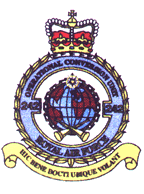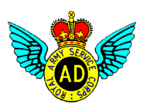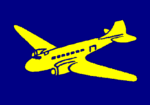Squadrons and the Operational Conversion Unit
 30 Squadron
30 Squadron
30 Squadron first received its Beverleys in April 1957 as a replacement for the Valettas it had then. At the time the Squadron was based at RAF Dishforth. From then until the Squadron disbanded in September 1967, the Squadron operated in Europe, the middle east and Africa.
As well as military duties, the Squadron was involved in humanitarian work, such as transporting relief supplies to Mauritius when that island was struck by a cyclone in early 1960.
34 Squadron 
The badge shown here predated the Squadron’s Beverley days, as it has a King’s Crown. The Squadron received its Beverleys in Singapore during October 1960.
Previously 48 Squadron had been operating a four aircraft Beverley flight from RAF Changi in Singapore. 34 Squadron took over and operated widely in the far east and even carried out flood relief work in South Vietnam. The Squadron was disbanded at RAF Seletar, Singapore in January 1968.
 47 Squadron
47 Squadron
47 Squadron was the first RAF Squadron to receive Beverleys in March 1956 at RAF Abingdon. The Squadron’s aircraft served in the UK and Middle East and Germany. In 1958 a Squadron Beverley made the first proving flight to the far east where it carried out freighting and air dropping trails.
The Squadron was disbanded in October 1967. The Disbandment was short lived and the Squadron was reformed in March 1968 with C130 aircraft.
 53 Squadron
53 Squadron
In February 1957, 53 Squadron gave up its Hastings for the Beverley, joining 47 Squadron at RAF Abingdon. The Squadron managed to get itself as close acquaintance with Guinness, and had a Squadron tie emblazoned with Guinness Toucans with bogie undercarriage and a Beverley tail unit.
In June 1963, the Squadron merged with 47 Squadron. Squadron members then moved on to form a Belfast Squadron.
 84 Squadron
84 Squadron
84 Squadron began to receive Beverleys at RAF Khormaksar in May 1958. Taking over from a Beverley Detachment from Abingdon. They immediately went to work re-supplying garrisons in the region. The Squadron had the task of landing the large Beverley at very dangerous airstrips where an overshoot would mean meeting up with the face of a large hill.
In September 1967, the Squadron gave up its Beverleys, and moved to Sharjah, where they were to become an Andover Squadron.
 242 Operational Conversion Unit
242 Operational Conversion Unit
242 OCU, based at RAF Dishforth, received its Beverley Flight in 1957. The OCU’s instructors trained aircrew and ground staff in the flying and maintenance of the aircraft. In 1961, the unit moved to RAF Thorney Island, where apparently the unit caused crusty old retired Admirals and Generals to complain about the noise of night flying. A mistake in embroidery work resulted in a batch of Squadron badges bearing the title ‘242 Operational Conversation Unit’.
242 OCU disbanded its Beverley flight in March 1967.
Army Air Despatch Units



RASC and RCT Air Despatch Units of the British Army were well known in Beverley Squadrons world-wide. These units were responsible for the packing and air-dropping of supplies wherever such services were required. The winged brevet was awarded for 20 operational or 40 training air-drops (or a combination of the two). The golden Dakota on a blue background flash was worn worldwide regardless of any army divisional sign, thus making Air Despatchers unique and easily recognisable. The flash was awarded to Air Despatch units in recognition of their service and sacrifice during the Battle of Arnhem in 1944.
Until the advent of the RCT, RAOC Heavy Drop units rigged and loaded Medium and Heavy Stressed Platforms which carried vehicles and artillery pieces. REME also had air drop responsibilities for a short while.